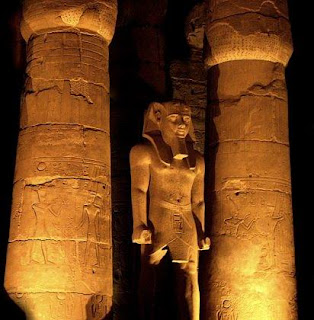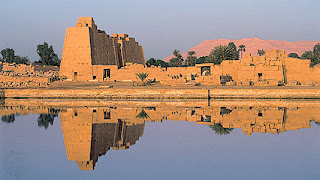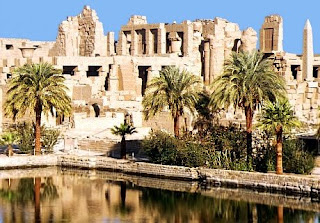Size matters
The
Sacred place (ipet isut)
The
The entire complex of Karnak has four precincts (walled enclosures) of which only one is open to the public (the precinct of Amun Re) the other three are 1, the precinct of Montu, precinct of Mut, and the precinct of Amenhotep IV.
Real long time to build!
 Karnak Temple map courtesy: bible-history.com
Karnak Temple map courtesy: bible-history.com
The total time taken for its construction is astounding; 1300 years! In its long history of construction about 30 Pharaoh Kings took charge and died; but additions and alternations went on! But most of the works in this complex were done between 1500 and 1100 BC. The entire complex comprising of temples, statues made of sandstones, obelisks, sphinxes, numerous inscriptions, bas reliefs and all the typical accompaniments of Pharaonic Temples. At present it is a sea of big and small broken structures some of them buried deep.
Amun (Amon) the super God
The
Akhenaton v/s Amun Re
The Pharaoh Kings had a practice of popularizing their image as the chosen one by God; this concept gave them a place in the heart of people and kept their rivals at bay. But Pharaoh Akhenaton (1379 BC) tried to make his countrymen monotheistic and asked to worship the Sun-God instead of Amun. He was a king of great clout and acquired a name Amenhotop IV (Queen Nefertiti one of the most beautiful women ever lived on earth was his wife). It was Akhenaton who installed the ‘sun-disc’ and his views on conflicted with the worship of Amun Re; the conflict went on until the death of Akhenaton. Tutankhamen who proceeded him retrieved the diminished the glory of Amun. In short God Amun had his last laugh.
Tutankhamen and the legendary curse!
Tutankhamen was the son of Akhenaton and Queen Nefertiti; he became king at the age of 9 but died mysteriously at the age of 18. In his short life he left more riddles than any of the Pharaohs. Tutankhamen married his half sister (Akhenaton’s child in another wife) and died shortly. The Egyptian legends had it that those who disturbed Tutankhamen’s tomb will die without delay. But these legends did not deter archaeologists from excavating the mummy.
Reason of a death on cost of 25 lives
The mummy had many treasures along with the mummified bodies of children. It so happened that about 25 persons associated with the retrieval died mysteriously in short time as warned by the ancient legends. But before their death these explorers could ascertain the cause of death ‘a fall from horseback and infection from open wound’!
Queen Halshapsut was yet another interesting character associated with the site she was the widow of 18 Dynasty Pharaoh who preceded Thutmose II; after her husband’s death she took over the throne and spread news to legitimize her action that she was the nominee of Amun Re and actually the daughter of the Pharaoh and not his wife as perceived! She built a temple (Deir el Bahri) dedicated to Amun Re. There is an obelisk with her image inscribed on it in perfect condition. The story behind is that her step son covered the image with mortar to express his hatred; but that action worked as a preservation to the image!
History of Construction
Excavations have brought the ruins of some of the structures belonging to the 11th Dynasty structures like the White Chapel,
Eighteenth Dynasty additions, the enclosure wall connecting 4th and 5th pylons with 14 papyrus columns and two obelisks of Halshapsut and Thutmose, Festival Hall of Thutmose known as Akhmenu etc were additions of the 18th dynasty. There are statues of gods, men, women and animals in abundance, one colossi stands on a platform is 20 feet in height even though it is only up to the waist and the rest lies fallen on the ground; just imagine how much would have been its actual height!
Nineteenth Dynasty additions, 18th and 19th centuries were the golden periods of Karnak Temple; at that time the Pharaohs won many battles and brought many booties and prisoners to the empire; some of the inscriptions depict the victories. There are stele and obelisks to proclaim the gains.
The Great Hypostyle Hall remains to be the most remarkable structure that still remains as the prime show of the site; it is 50,000 sq feet in area, roof that rested on 134 columns arranged in 16 rows (two middle rows have taller columns with height of 33 feet) had collapsed long ago. The Great Hypostyle Hall has a circumference of 80 feet.
Precinct of Amun Re
This is dedicated to the principal of the Theban Triad (Amun, his wife Mut and their son Khoms); it is the largest structure in the complex with a built in area of 25,000 sq meters. In its southwest part there is the mega open-air assembling area with small and large stone work ruins scattered and waiting for re assembly. In this side temples of Opet and Khons lie in a dilapidated condition. There is a museum in the northwest corner.
The Temple of Montu is a part of the Karnak Temple Complex dedicated to the deity of Montu; son of Amun Re and Mut; this temple with 200,00 sq meters is in a neglected state. Its main features excluding the
Precinct of Mut is 15,000 sq meters of ruins, with a crescent shaped lake at its middle; this lake is fed from an underground spring. The Mut; known as the Mother Goddess was worshipped up to the 1st century and later it lost the status and left uncared. At present no structure stands vertical! It is a pitiable sight to see so many granite statues broken and lying flat in the hot sun; fortunately admission to the precinct is banned to the public.
Temple of Amenhotep; built by Pharaoh King Akhenaton is out side of the compound of temple of Amun Re, the main temple structure was Gempaaten is in a severely damaged state. The original structure was a really massive one with a size of 130 * 216 meters made of red granite and decorated with statues of Akhenaton, sphinx etc. The structure had no roof and the platform for sacrifice was exposed to sun; its entrance was believed to be facing west and that led to an open court. This hall is surrounded by square pillars and statues of Akhenaton and Nefertiti. Public is at present not admitted to this complex.
The Christian Period
In the AD 4th century
A treasure house
The Karnak Temple Complex; with most of its monuments ruined and some still standing intact is a real treasure of the world’s heritage. With some arduous efforts these sites can be revived to make it the most beautiful and unparalleled sites in the world. A revived













0 comments:
Post a Comment